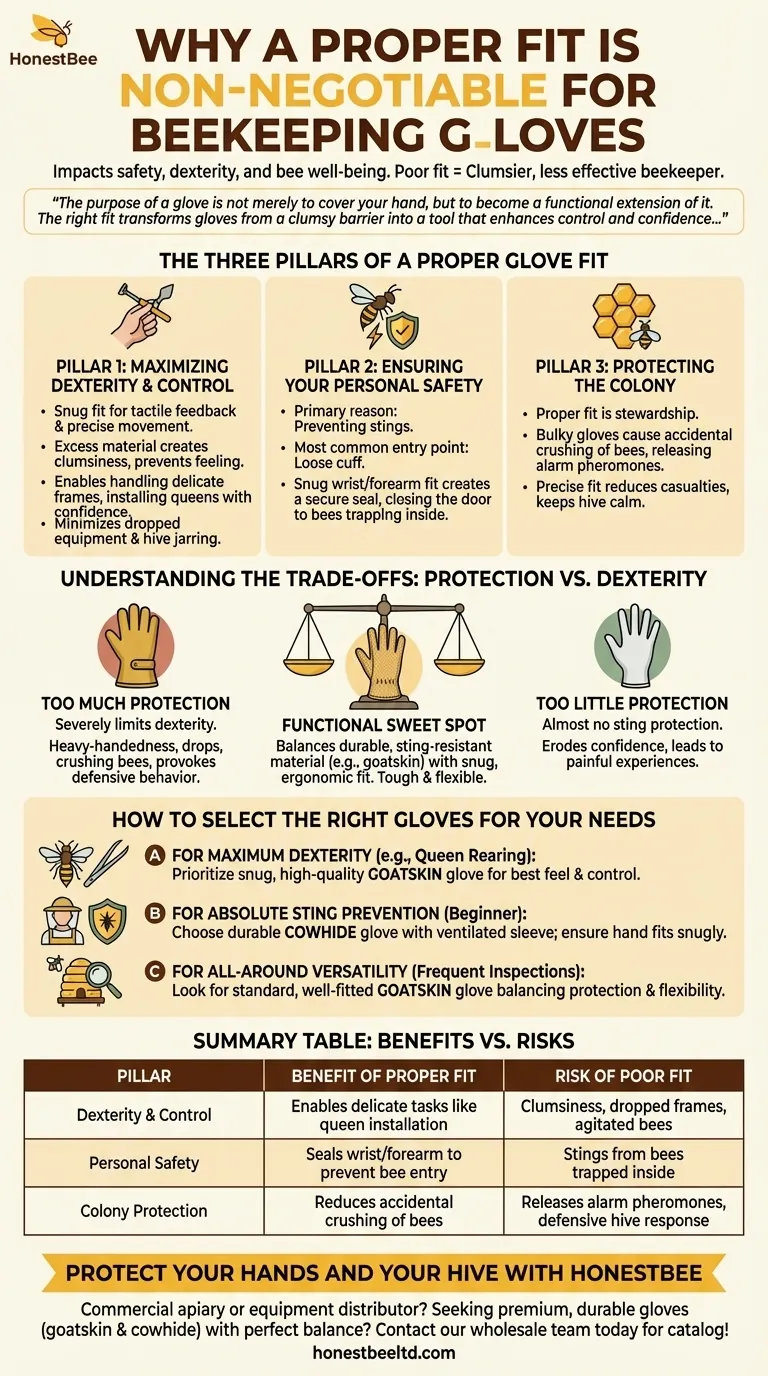A proper fit for beekeeping gloves is non-negotiable because it directly impacts your safety, your dexterity, and the well-being of your bees. Poorly fitting gloves not only fail to protect you but can actively make you a clumsier, less effective beekeeper. They compromise protection by allowing bees inside, reduce your ability to handle delicate hive components, and increase the risk of accidentally harming the colony you are trying to nurture.
The purpose of a glove is not merely to cover your hand, but to become a functional extension of it. The right fit transforms gloves from a clumsy barrier into a tool that enhances control and confidence, allowing you to focus on the hive instead of fumbling with equipment.

The Three Pillars of a Proper Glove Fit
A correctly sized glove delivers critical advantages in three distinct areas. Understanding these pillars is the first step to moving from a novice to a confident beekeeper.
Pillar 1: Maximizing Dexterity and Control
A snug fit is essential for tactile feedback and precise movement. Excess material in the fingertips makes you clumsy and unable to feel what you are doing.
Well-fitted gloves allow you to handle delicate frames, install a new queen, or perform other intricate tasks with confidence. This control minimizes the chance of dropping equipment or jarring the hive, which can agitate the colony.
Pillar 2: Ensuring Your Personal Safety
The primary reason to wear gloves is to prevent stings, and fit is a major component of that protection. The most common entry point for a bee is a loose cuff around the wrist.
A glove that fits snugly at the wrist and forearm creates a secure seal. This effectively closes the door, preventing bees from crawling inside where they are trapped and almost certain to sting.
Pillar 3: Protecting the Colony
Your goal is to be a steward of the hive, and a proper glove fit is an act of stewardship. Bulky, ill-fitting gloves make it easy to accidentally crush bees between frames or against the hive body.
This not only kills individual bees but can also release alarm pheromones, escalating the defensive response of the entire colony. A precise fit reduces these accidental casualties and helps keep the hive calm.
Understanding the Trade-offs: Protection vs. Dexterity
Choosing a glove is an exercise in balancing two competing needs. Over-prioritizing one at the expense of the other often leads to poor outcomes.
The Problem with "Too Much" Protection
Extremely thick, rigid gloves may seem like the safest option, but they severely limit your dexterity. This forces you to be heavy-handed, increasing the risk of dropping a frame or crushing bees.
Ultimately, the clumsiness caused by overly thick gloves can provoke the very defensive behavior you are trying to avoid.
The Danger of "Too Little" Protection
Conversely, very thin gloves, such as simple cotton or nitrile disposables, offer excellent dexterity but provide almost no protection from stings. A bee’s stinger will easily penetrate such thin material.
Relying on inadequate gloves erodes confidence and can lead to a painful experience, discouraging new beekeepers.
Finding the Functional Sweet Spot
The ideal beekeeping glove balances durable, sting-resistant material with a snug, ergonomic fit. Materials like goatskin are highly valued because they are both tough and flexible.
The fit provides the dexterity, while the material provides the necessary protection. This combination allows you to work confidently and gently.
How to Select the Right Gloves for Your Needs
Your ideal glove depends on balancing your need for protection with your comfort level and the tasks you perform most often.
- If your primary focus is maximum dexterity for delicate work (like queen rearing): Prioritize a snug, high-quality goatskin glove that offers the best possible feel and control.
- If your primary focus is absolute sting prevention as a beginner: Choose a durable cowhide glove, perhaps with a ventilated canvas sleeve, ensuring the hand portion still fits snugly without excess material.
- If your primary focus is all-around versatility for frequent inspections: Look for a standard, well-fitted goatskin glove that offers a reliable balance of protection and flexibility for common tasks.
Ultimately, the right gloves are the ones that empower you to be a calm, confident, and effective beekeeper.
Summary Table:
| Pillar | Benefit of Proper Fit | Risk of Poor Fit |
|---|---|---|
| Dexterity & Control | Enables delicate tasks like queen installation | Clumsiness, dropped frames, agitated bees |
| Personal Safety | Seals wrist/forearm to prevent bee entry | Stings from bees trapped inside the glove |
| Colony Protection | Reduces accidental crushing of bees | Releases alarm pheromones, defensive hive response |
Protect Your Hands and Your Hive with HONESTBEE
Are you a commercial apiary or beekeeping equipment distributor seeking high-quality, durable gloves that offer the perfect balance of protection and dexterity? HONESTBEE supplies premium beekeeping gloves, including flexible goatskin and durable cowhide options, designed for professionals who demand performance and safety.
Let us help you equip your beekeepers with the right tools for confidence and success. Contact our wholesale team today to discuss your needs and request a catalog!
Visual Guide

Related Products
- Mesh Ventilated 3 Layer Goatskin Beekeepers Gloves for Beekeeping
- Goatskin Leather Beekeeper Gloves with Vent Long Sleeve for Beekeeping Honey Bee Sting Proof Protection
- Goat Skin Leather Bee Sting Proof Beekeeping Gloves with Canvas Sleeve
- Professional Drop-Style Hive Handles for Beekeeping
- HONESTBEE Professional Long Handled Hive Tool with Precision Cutting Blade
People Also Ask
- How do beekeeping gloves increase comfort during long sessions? Enhance Focus and Reduce Fatigue
- What factors should be considered when selecting beekeeping gloves? Balance Protection and Dexterity
- What is the recommendation for beginning beekeepers regarding gloves? Build Confidence and Safety
- Why do some beekeepers choose not to wear protective gear? Experience vs. Dexterity in Hive Management
- Why is it important to have gloves available even if not always worn? Essential Risk Management for Beekeepers



















